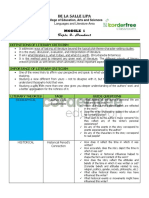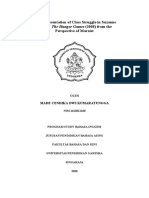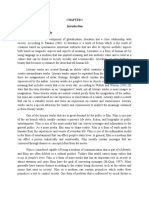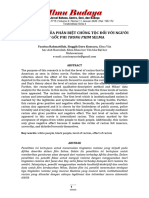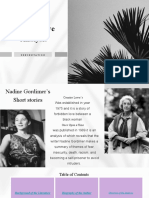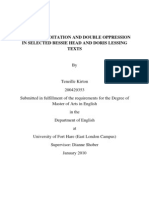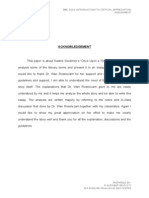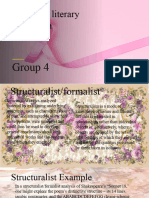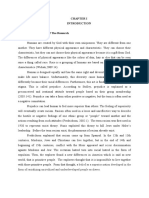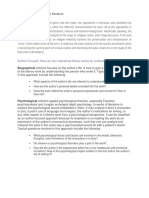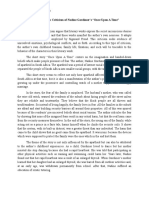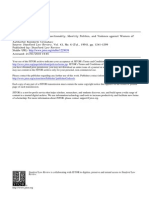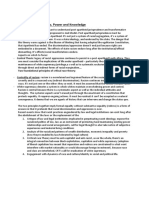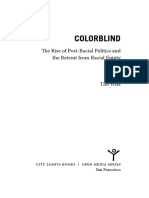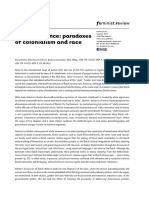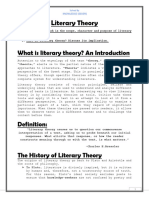1
Chapter 3
Research Methodology
This chapter contains the following areas of concern:
research design, corpus of the study, data collection, data
analysis, and ethical considerations.
Research Design
This study employs qualitative research design specifically
utilizing critical race theory in analyzing realities of racism
and apartheid in South Africa that are reflected in Nadine
Gordimer’s Once Upon A Time to reveal how these literary pieces
reflect his art of imagination through experience. CRT, or
critical race theory, is an interpretive and theoretical
framework that looks at the manifestation of racism and race in
the prevailing cultural expressions (Delgado et al., 2012).
The researchers will employ Critical Race Theory (CRT) as it
provides a powerful framework for analyzing the realities of
racism and apartheid in South Africa as reflected in Nadine
Gordimer’s Once Upon a Time. CRT allows for an in-depth
examination of how systemic racism and entrenched power
structures are represented in the text, uncovering the ways in
which race, privilege, and fear intersect within apartheid-era
South Africa.
23
� This method highlights how the narrative exposes the
anxieties of white South Africans, the constructed barriers of
segregation, and the dehumanization of marginalized groups. By
interrogating the underlying ideologies and social dynamics
presented in the story, CRT fosters a deeper understanding of the
lived experiences of those oppressed under apartheid and the
perpetuation of racial hierarchies.
Through this approach, the research not only critiques the
social and political constructs of the time but also underscores
the ongoing relevance of these issues in contemporary discussions
about race and inequality. The insights gained can contribute to
broader discourses on justice and equity, empowering readers to
critically engage with the legacies of apartheid and systemic
racism.
Corpus of the Study
The corpus of the study is the frame story of Nadine Gordimer
entitled Once Upon A Time. This story is taken online at
https://www.jstor.org/stable/40548017.
24
�Data Gathering Procedure
The researchers will search, download, and have one print
copy of Once Upon A Time by Nadine Gordimer that specifically
addressed the forms of racism that are reflected on the literary
convention and how the story reflects the social conditions of
apertheid in south africa to collect the necessary data.
Pre-Analysis Phase
Before delving into the text, the preparatory phase is
essential for setting the foundation of the study. This begins
with a comprehensive review of the historical and social context
of apartheid South Africa. Understanding the systemic racism and
segregation of this period provides critical insight into the
setting that shaped Gordimer’s work. Scholarly research on
apartheid and its societal impacts is collected, emphasizing
sources that align with CRT principles.
Simultaneously, the researcher familiarizes themselves with
Nadine Gordimer’s broader oeuvre, focusing on her views about
race, inequality, and resistance to oppression. Interviews,
essays, and critiques by Gordimer are examined to uncover her
intentions and recurring motifs in her storytelling. This phase
25
�also involves a thorough review of CRT literature to identify key
concepts such as systemic racism, white privilege, and
intersectionality that will guide the analysis.
Finally, a detailed framework is developed for analyzing the
four literary conventions—plot, character, theme, and symbolism.
This includes designing coding categories and identifying
potential markers of racism within the story. The pre-analysis
phase ensures that the researcher approaches the text with
clarity and a well-defined lens.
During Analysis Phase
The heart of the study lies in the analysis phase, which
begins with a close reading of Once Upon a Time. This step
involves systematically examining the story to uncover explicit
and implicit forms of racism in the literary conventions outlined
in the research questions.
The plot is analyzed for its structural elements and events
that reflect societal fears and systemic inequalities. Key
moments, such as the construction of the wall and its escalating
fortifications, are dissected for their racial implications and
parallels to apartheid’s policies of segregation and control.
26
� In the character analysis, the focus shifts to how
individuals and groups are represented. This includes assessing
whether characters embody racial stereotypes or symbolize broader
social hierarchies. Special attention is given to the role of
marginalized characters and how they reflect the silenced or
oppressed voices in apartheid-era society.
The theme of the story is explored to uncover its central
messages about fear, division, and societal decay. The study
identifies how Gordimer critiques apartheid through the implicit
commentary woven into her narrative. This thematic analysis is
informed by CRT concepts such as counter-narratives and systemic
critique.
Finally, the symbolism in the story is scrutinized,
particularly objects like the barbed wire, which symbolize both
physical and psychological barriers. These symbols are
interpreted within the context of apartheid’s racial divisions,
demonstrating how Gordimer uses metaphor to critique systemic
racism.
Emerging patterns and themes are coded and categorized during
this phase. Qualitative data analysis tools or manual coding
methods are employed to group evidence according to recurring
motifs, aligning them with CRT principles. Throughout the
27
�analysis, the researcher maintains a reflective journal to
capture observations, challenges, and evolving interpretations.
Post-Analysis Phase
The final phase focuses on synthesizing the findings and
ensuring their validity through critical reflection and
triangulation. The identified themes are revisited and cross-
referenced with historical research and CRT literature to confirm
their relevance and accuracy. This step ensures that the study
does not rely solely on subjective interpretation but is grounded
in established theoretical and historical frameworks.
Comparisons are made between the story’s portrayal of racism
and the real-life conditions of apartheid South Africa,
demonstrating how Gordimer’s work reflects and critiques societal
realities. The insights from the coding process are integrated
into a cohesive narrative, showing how racism permeates the
story’s plot, characters, themes, and symbols.
Finally, the findings are contextualized within the broader
field of apartheid literature and CRT. This involves connecting
the study’s conclusions to existing scholarship on Gordimer and
racism in literature. The post-analysis phase concludes with the
28
�preparation of a detailed report that addresses the research
questions and highlights the significance of Gordimer’s work in
exposing and critiquing systemic racism.
Data Analysis
This study employs Critical Race Theory (CRT) serves as a
robust framework for analyzing systemic racism as portrayed in
Nadine Gordimer’s Once Upon a Time. Rooted in the idea that
racism is not limited to overt individual prejudice but is deeply
embedded in the culture, institutions, and structures of society,
CRT aligns closely with the historical context of apartheid South
Africa (Delgado, R., & Stefancic, J. 2012)
Structural and Systemic Racism
At the core of CRT is the recognition that racism operates
on a structural level. It is not merely the result of individual
attitudes but a feature of societal systems designed to maintain
racial inequality. This principle provides a lens through which
Gordimer’s depiction of fear, division, and security measures can
be interpreted as reflections of apartheid-era segregation.
Delgado and Stefancic (2012) emphasize that systemic racism is
deeply ingrained in societal norms and policies, making it
resistant to superficial changes. The family’s construction of
walls and security measures in the story symbolizes the
29
�psychological and physical barriers enforced by apartheid to
sustain racial divisions.
Interest Convergence
Another significant principle of CRT is interest
convergence, which asserts that progress for marginalized groups
often aligns with the interests of those in power. Derrick Bell
(1980), who introduced this concept, argued that racial equity is
often advanced only when it benefits dominant groups. In Once
Upon a Time, the family’s actions—motivated by fear and the
desire to preserve privilege—reflect this dynamic. Their
increasing investment in security mirrors the broader societal
efforts under apartheid to protect the interests of the ruling
white minority, perpetuating systems of oppression under the
guise of self-preservation.
Counter-Narratives
Storytelling is central to CRT, particularly the use of
counter-narratives to amplify marginalized voices and challenge
dominant perspectives. Gordimer’s work functions as a counter-
narrative, critiquing apartheid and exposing its dehumanizing
effects. Solórzano and Yosso (2002) underscore the importance of
counter-narratives in revealing the lived realities of oppressed
communities. Although Once Upon a Time does not directly center
30
�on oppressed characters, the story’s underlying critique of
segregation and fear serves as a powerful commentary on the
consequences of systemic racism.
Intersectionality
Kimberlé Crenshaw’s (1991) concept of intersectionality,
another key tenet of CRT, highlights how various aspects of
identity—such as race, class, and gender—intersect to create
unique experiences of oppression. This principle is particularly
relevant in examining the interplay of privilege and
vulnerability within the family in Gordimer’s story. Their
socioeconomic status shapes their fears and actions, illustrating
how privilege operates within systems of inequality.
Critique of Colorblindness
CRT also challenges the notion of colorblindness, which
assumes that ignoring race will lead to equality. Delgado and
Stefancic (2012) argue that this perspective often perpetuates
inequality by obscuring the systemic nature of racism. In Once
Upon a Time, moments where racial realities are downplayed or
ignored highlight how avoidance can exacerbate division and
conflict, reinforcing apartheid’s injustices.
31
� The primary data for this analysis is the text of Gordimer’s
Once Upon a Time. This narrative, with its allegorical richness
and thought-provoking symbolism, delves into themes of fear,
segregation, and racial inequality, making it particularly
suitable for CRT analysis. The study focuses on several aspects
of the text: narrative structure, symbolic representations (e.g.,
the wall and security systems), character behaviors and fears,
and the socio-historical context of apartheid South Africa.
Together, these elements reveal Gordimer’s critique of systemic
racism and its pervasive effects on both oppressors and the
oppressed.
Critical Race Theory offers a theoretical framework for
understanding these dynamics. Specifically, CRT explores race as
a social construct, the intersections of race and class, and the
ways racial privilege operates in society (Delgado & Stefancic,
2017). By applying CRT to Once Upon a Time, this analysis
uncovers how racial hierarchies and privileges manifest within
the story. For instance, the idea of whiteness as property is
evident in the family's focus on fortifying their home and
securing their "space" (Harris, 1993). Meanwhile, the narrative’s
counter-narratives challenge dominant ideologies of fear and
segregation, offering a subtle but powerful critique of
apartheid.
32
� The preparation of data involved segmenting the story into
key passages that align with CRT themes. Significant segments
include the family’s fear-driven behavior, their reliance on
security measures, and the portrayal of the “outsiders.” These
passages were coded to identify recurring motifs and symbols,
such as the wall, barbed wire, and alarm systems, which serve as
metaphors for racial segregation and apartheid-era policies. The
analysis further contextualized these elements within the broader
socio-political framework of apartheid South Africa, recognizing
Gordimer’s intent as a critic of systemic inequality (Clingman,
1992).
The analysis followed a structured approach, starting with a
close reading of the text. This process uncovered the racial
subtexts and symbolic elements within the story, particularly
those tied to fear and segregation. Key symbols such as the wall
and security systems represent apartheid’s spatial control and
the irrational fear of the "other." Gordimer’s use of a fairy
tale format was also examined, revealing how it critiques
societal norms related to race and privilege. Finally, the text
was analyzed within its intertextual and historical context,
linking its themes to the lived realities of apartheid.
33
�Ethical Considerations
In conducting the study on racism as reflected in Nadine
Gordimer’s Once Upon a Time using Critical Race Theory (CRT),
ethical considerations are paramount. The research addresses
sensitive topics, including apartheid and systemic oppression,
requiring careful attention to the dignity, accuracy, and social
impact of the analysis. Below are key ethical considerations
guiding the study:
1. Sensitivity to Context and Subject Matter
The intent of this study is to critically examine how racism
and systemic oppression are represented in Once Upon a Time,
while maintaining respect for the historical and cultural weight
of apartheid. Racism, a deeply rooted social issue, necessitates
a sensitive and nuanced approach to avoid trivializing the lived
experiences of those affected by it. Researchers must strive to
present their analysis with integrity, avoiding any form of
sensationalism. By framing apartheid as a system of
34
�institutionalized oppression, the study will contextualize
Gordimer’s critique without reinforcing harmful stereotypes.
2. Respect for Diverse Perspectives
The study recognizes the multiplicity of voices and
experiences represented in the text and its broader historical
context. Gordimer, a white South African, used her literary
platform to critique apartheid, which requires a balanced
approach that acknowledges her positionality while also centering
the experiences of those who lived under apartheid's systemic
oppression. Highlighting counter-narratives within the story
aligns with CRT’s principle of amplifying marginalized voices.
This ensures that the analysis goes beyond a surface-level
reading and engages with the deeper social implications of the
text.
3. Accuracy in Applying Critical Race Theory
The intent of using CRT is to illuminate the systemic nature
of racism depicted in Gordimer’s work. It is essential to apply
CRT principles accurately, ensuring that its key concepts—such as
structural racism, intersectionality, and counter-storytelling—
are neither misrepresented nor used in a reductive manner. This
requires a thorough grounding in CRT scholarship and careful
citation of foundational works. By doing so, the research
35
�contributes to both literary analysis and the broader discourse
on racial justice.
4. Academic Integrity
Transparency and honesty are critical to the research
process. The study will rigorously cite all sources, including
literary criticism, CRT texts, and historical analyses of
apartheid, adhering to APA 6th edition standards. Proper
attribution ensures that the work builds on existing scholarship
while avoiding plagiarism. Moreover, engaging with a wide range
of perspectives will provide a more balanced and comprehensive
analysis.
5. Reflexivity and Researcher Bias
It is important for researchers to acknowledge their own
positionality and potential biases when analyzing themes of race
and racism. Reflexivity involves critically reflecting on how the
researcher’s background, experiences, and assumptions may
influence their interpretations. This awareness helps prevent the
imposition of personal biases onto the text and fosters a more
authentic engagement with Gordimer’s work.
6. Cultural Sensitivity
36
� The themes of fear, division, and systemic racism in Once
Upon a Time must be approached with cultural and historical
sensitivity. Recognizing the traumatic legacy of apartheid, the
study will handle the text’s content with care, ensuring that it
does not exploit or trivialize the experiences of those affected
by racial oppression. This includes avoiding overly modern
interpretations that might overshadow the historical realities
depicted in the story.
7. Accessibility and Social Impact
The intent of this research extends beyond literary
analysis; it seeks to contribute meaningfully to conversations
about systemic racism and its representations in literature. As
such, the findings should be communicated in an accessible
manner, avoiding academic jargon that may alienate broader
audiences. Additionally, the research should aim to provoke
thoughtful dialogue and raise awareness about the ongoing impact
of systemic racism.
37
�38










